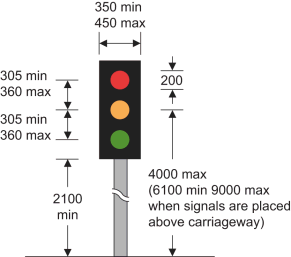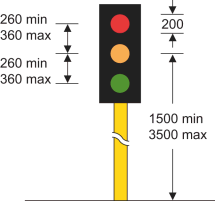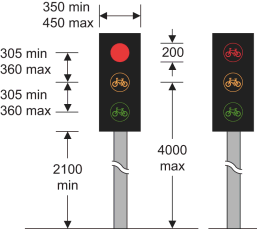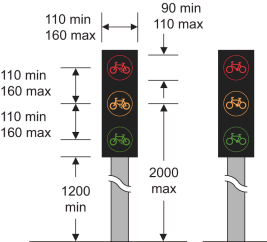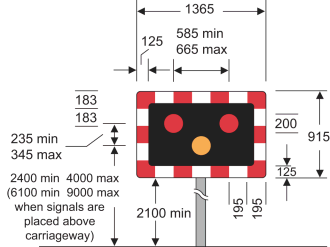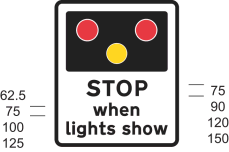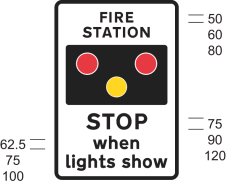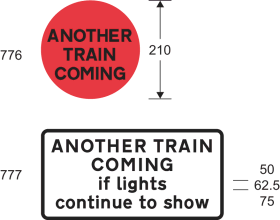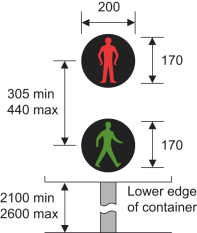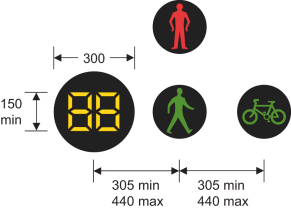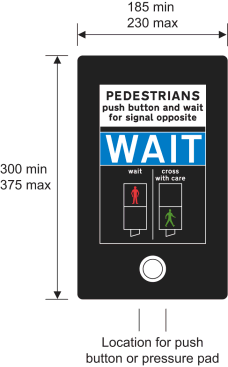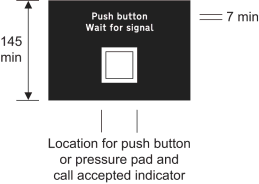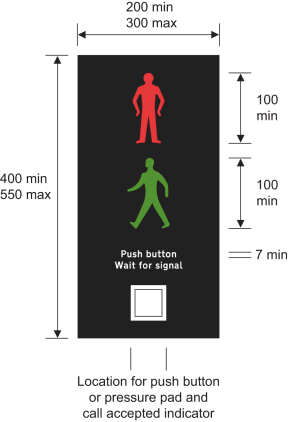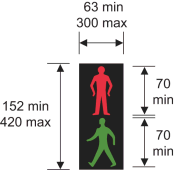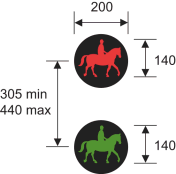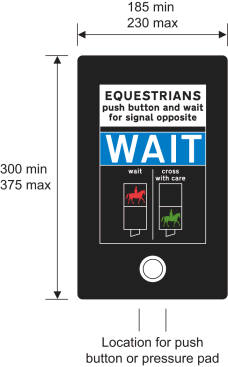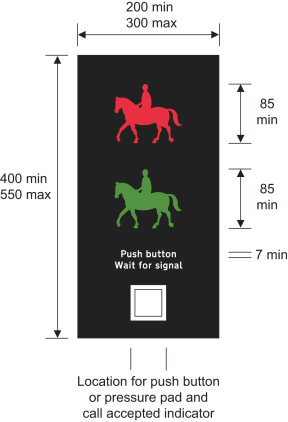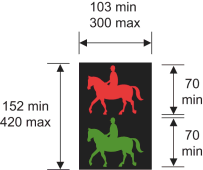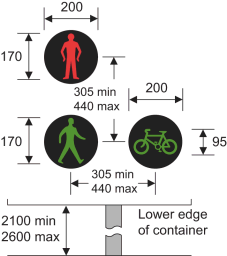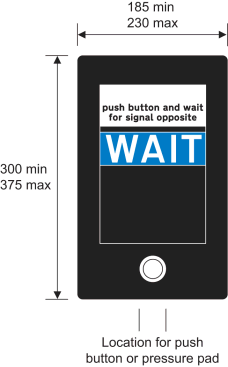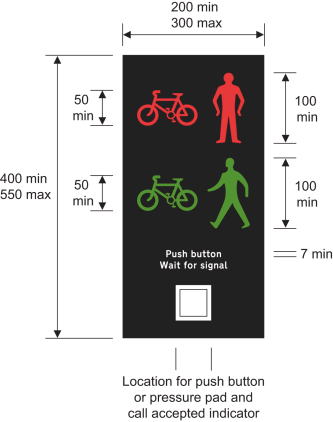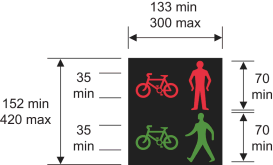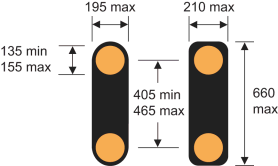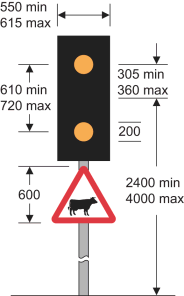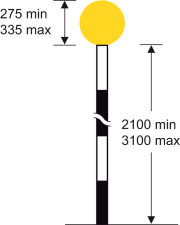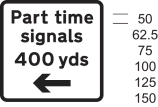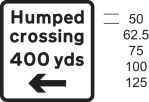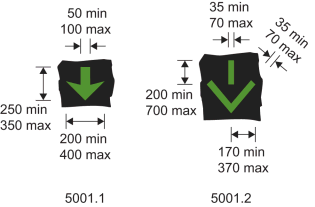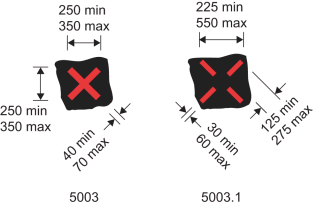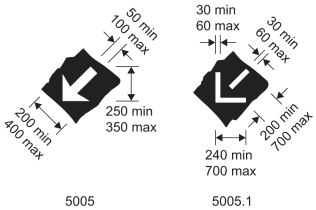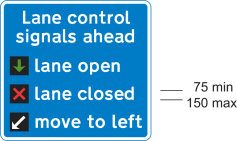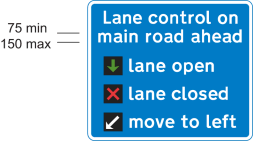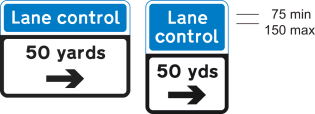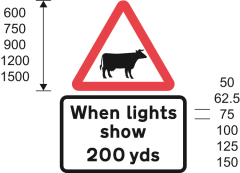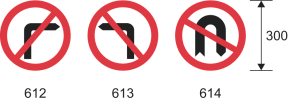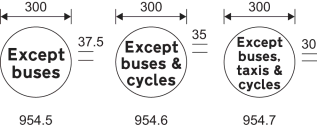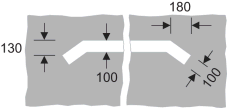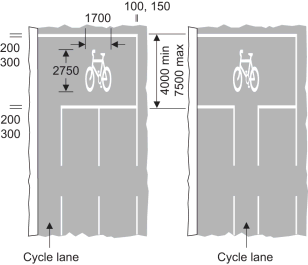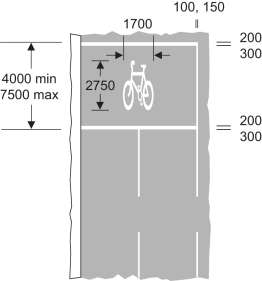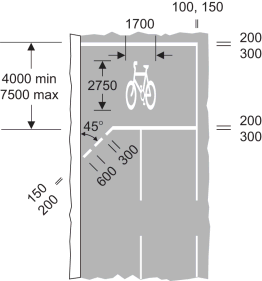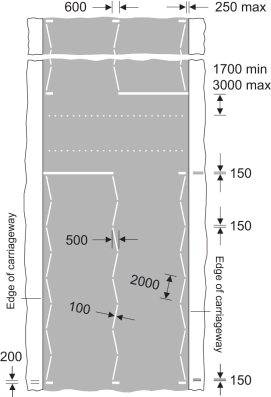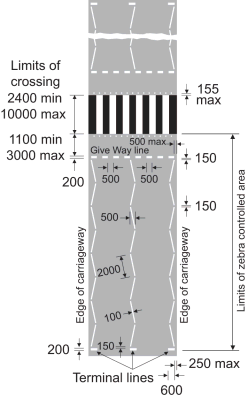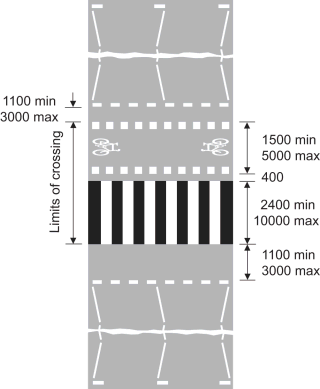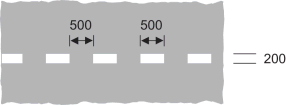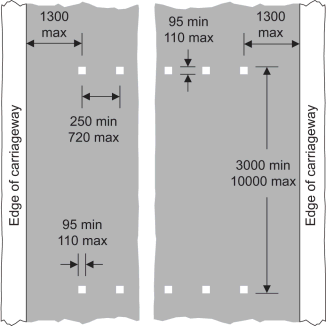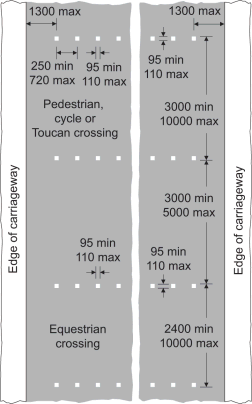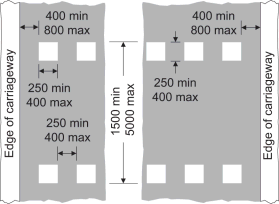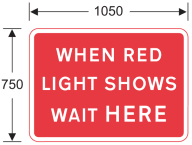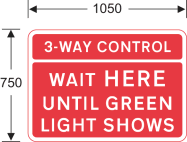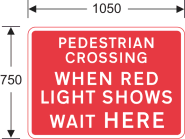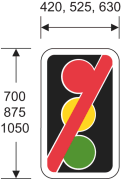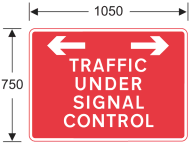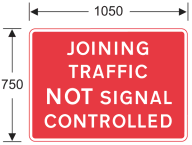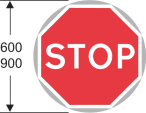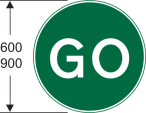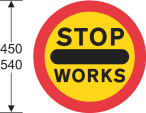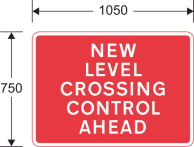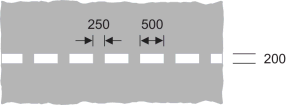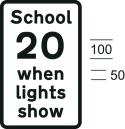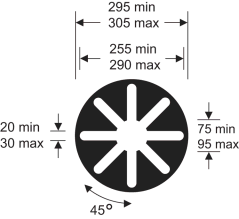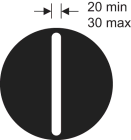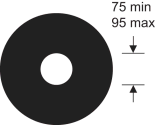Regulation 3, Direction 3
SCHEDULE 14Signs for traffic control by light signals, signs for crossings, and signs for lane control
PART 1Provisions applying to signs in Parts 2 and 3
General provision about signs provided for in this Schedule
1.—(1) A warning, information, requirement, restriction or prohibition of a description in an item in column 2 of the sign table in Part 2 must be conveyed by a sign which—
(a)is of the colour and type; and
(b)complies with the requirements as to size,
provided for in the diagram in column 3 of that item, or that diagram as varied in accordance with column 4 (see paragraph 2 for further permitted variations applicable to items 1 and 3 in the table).
(2) In the case of the description at—
(a)item 8 (another train or tramcar may be about to pass over the crossing);
(b)item 25 (cattle crossing ahead); and
(c)item 41 (supervised cattle crossing ahead),
the warning is to be conveyed by both signs shown in the diagram and sub-paragraph (1) applies to each of those signs.
(3) Where the significance of a sign, or elements of a sign, is given in this Part, the significance is to be treated as forming part of the description for that sign.
(4) Where operating requirements for a light signal which forms part of a sign provided for in this Schedule are given in this Part, those requirements are an aspect of the type of the sign.
(5) Where in respect of a sign provided for in the Part 2 sign table there is a number in column 5, the corresponding paragraph number in Part 4 applies to the sign in question.
(6) Part 5 makes provision about the precedence of vehicles and pedestrians respectively, and generally with respect to the movement of traffic (including pedestrians), at and in the vicinity of section 25 crossings.
(7) A number appearing in column 6 of an item in the Part 2 sign table means that the Schedule 14 General Direction so numbered applies to the sign to which the item relates (with Schedule 14 General Direction 1 being an interpretive provision).
Application of the Part 3 table to certain traffic light signs provided for in the Part 2 table
2.—(1) The diagram at item 1 of the Part 2 sign table may be varied to show a light signal provided for in an item in the sign table in Part 3 (the green arrow signal, signals to control tramcars and the green pedal cycle symbol) in a position specified in column 4 of the Part 3 sign table for that light signal.
(2) The diagram at item 3 of the Part 2 sign table may be varied to show a light signal provided for at items 1 to 7 of the Part 3 sign table (the green arrow signal and signals to control tramcars) in a position specified in column 4 of the Part 3 sign table for that light signal.
(3) The reference to diagrams A to D in column 4 of the Part 3 sign table is to the diagrams above that table.
(4) A signal provided for in the Part 3 sign table must be of the colour and type, and comply with the requirements as to size, provided for in the diagram in column 3 of the Part 3 sign table for that signal.
(5) The green arrow may point to the left, the right, straight on or at any other angle that is appropriate for indicating the direction to be taken by vehicular traffic.
(6) When placed at position 3 of diagram C or position 2 of diagram D, the green arrow signal replaces the green signal shown in the diagram at item 1 or 3 of the Part 2 sign table.
Light signals to be ES compliant
3.—(1) A light signal that forms part of a sign provided for in the Part 2 sign table that is mentioned in sub-paragraph (2) must be ES compliant (including, subject to sub-paragraph (3), those light signals that form part of such a sign by virtue of paragraph 2).
(2) The signs are those provided for at items 1 to 3, 5, 8 (shown in the diagram marked as “776”), 9, 15, 19 and 25.
(3) The requirement in sub-paragraph (1) does not apply to light signals for the control of tramcars (items 2 to 7 of the Part 3 sign table).
(4) A light signal is ES compliant if the signal head, in relation to each aspect of performance in column 2 of the table below, satisfies the requirement or test specification of British Standard BS EN12368: 2015(1) specified in column 3 (but see sub-paragraph (5) for an exception).
(1) Item | (2) Aspect of performance | (3) Requirement or test specification and class |
|---|---|---|
| 1 | Protection rating | Class IV: IP 55 |
| 2 | Operating temperature range | Class A |
| 3 | Luminous intensity | Performance level 3, class 2 |
| 4 | Distribution of luminous intensity | Type M |
| 5 | Maximum signal phantom | Class 5 |
| 6 | Signal lights incorporating symbols | Class S1 |
| 7 | Background screen | the requirement in paragraph 6.9 of the British Standard |
| 8 | Impact resistance | Class IR2 |
(5) A light signal that forms part of the traffic light signals provided for at item 4 of the Part 2 sign table is ES compliant if the signal head, in relation to each aspect of performance in column 2 of the table below, satisfies the requirement or test specification of British Standard BS EN12368: 2015 in column 3.
(1) Item | (2) Aspect of performance | (3) Requirement or test specification and class |
|---|---|---|
| 1 | Protection rating | Class IV: IP 55 |
| 2 | Operating temperature range | Class A |
| 3 | Luminous intensity | Performance level 1, class 1 |
| 4 | Distribution of luminous intensity | Type W |
| 5 | Maximum signal phantom | Class 1 |
| 6 | Signal lights incorporating symbols | Class S1 |
| 7 | Impact resistance | Class IR2 or IR3 |
Traffic light signals
4.—(1) Sub-paragraph (2) applies to the red, amber and green light signals shown in the diagram in column 3 of the Part 2 sign table at each of items 1 to 4 (types of traffic light signals), including, for items 1 and 3, when, as described in paragraph 2(6), the green signal is a green arrow.
(2) The order of illumination for the light signals must be as follows—
(a)red;
(b)red and amber together;
(c)green;
(d)amber.
(3) The duration of the period when the red and amber light signals are illuminated together must be 2 seconds.
(4) The duration of the period when the amber light signal is illuminated on its own must be 3 seconds.
(5) The requirement in sub-paragraph (3) or (4) is to be treated as having been met if the duration is 0.25 seconds more, or less, than that specified.
5.—(1) This paragraph applies to traffic light signals.
(2) The significance of the light signals to which paragraph 4(2) applies, when illuminated, is that specified in sub-paragraphs (3) to (9).
(3) Subject to sub-paragraphs (4) to (6), the red signal conveys the prohibition that vehicular traffic must not proceed beyond the stop line.
(4) Sub-paragraph (5) applies on an occasion where a vehicle is being used for at least one of the purposes set out in sub-paragraph (6) and the observance of the prohibition in sub-paragraph (3) would be likely to hinder the use of the vehicle for that purpose.
(5) The prohibition conveyed is that the vehicle must not proceed beyond the stop line in such a manner or at such a time as to be likely to endanger any person or to cause the driver of another vehicle to change its speed or course in order to avoid an accident.
(6) The purposes are—
(a)fire and rescue authority;
(b)Scottish Fire and Rescue Service;
(c)ambulance;
(d)blood service;
(e)providing a response to an emergency at the request of an NHS ambulance service;
(f)bomb or explosive disposal;
(g)special forces
(h)police; and
(i)National Crime Agency.
(7) Red and amber signals illuminated together denote an impending change to green but conveys the same prohibition as the red signal.
(8) A green signal indicates—
(a)subject to paragraphs (b) and (c), that vehicular traffic may proceed beyond the stop line and proceed straight on or to the left or to the right;
(b)where the signal is an arrow, vehicles may only proceed in the direction indicated by the arrow;
(c)where the signal is a pedal cycle symbol, only vehicles which are pedal cycles may proceed.
(9) An amber signal, when shown alone, conveys the same prohibition as red, except that, as respects any vehicle which is so close to the stop line that it cannot safely be stopped without proceeding beyond the stop line, it conveys the same indication as the green signal which was shown immediately before it.
(10) Sub-paragraph (11) gives the significance, when illuminated, of the green arrow signal when, by virtue of the variation permitted in paragraph 2, it is included in the traffic light signals provided for at—
(a)item 1 of the Part 2 sign table;or
(b)item 3 of the Part 2 sign table,
at a position other than position 3 of diagram C or position 2 of diagram D.
(11) The significance is that vehicular traffic may proceed beyond the stop line in the direction indicated by the arrow irrespective of which other light signals forming part of the sign are illuminated.
(12) Sub-paragraph (13) gives the significance, when illuminated, of the pedal cycle symbol when, by virtue of the variation permitted in paragraph 2, it is included in the traffic light signals provided for at item 1 of the Part 2 sign table.
(13) The significance is that pedal cycles may proceed beyond the stop line and proceed straight on or to the left or to the right irrespective of which other light signals forming part of the sign are illuminated.
(14) Vehicular traffic proceeding beyond a stop line must proceed with due regard to the safety of other road users and subject to any direction given by a constable in uniform, a traffic officer in uniform or a traffic warden or to any other applicable prohibition or restriction.
(15) This paragraph does not apply to tramcars.
Tramcars
6.—(1) This paragraph applies where, by virtue of the variation permitted in paragraph 2, the traffic light signals provided for at item 1 or 3 of the Part 2 sign table includes a light signal provided for at items 2 to 7 of the Part 3 sign table (which relate to light signals for controlling tramcars).
(2) The order of illumination for the light signal must be as follows—
(a)the horizontal line (item 3);
(b)the vertical or a diagonal line (items 4 to 6);
(c)the central circle (item 7).
7. The significance of the light signal is that—
(a)the horizontal line conveys the prohibition that a tramcar must not proceed beyond the stop line;
(b)the vertical line indicates that a tramcar may proceed beyond the stop line and proceed straight ahead;
(c)the diagonal line shown in the diagram at item 5 indicates that a tramcar may proceed beyond the stop line and proceed to the left;
(d)the diagonal line shown in the diagram at item 6 indicates that a tramcar may proceed beyond the stop line and proceed to the right; and
(e)the central circle conveys the prohibition that a tramcar must not proceed beyond the stop line except that, as respects a tramcar which is so close to the stop line that it cannot safely be stopped without proceeding beyond the stop line, it conveys the same indication as the aspect which was shown immediately before it.
Light signals at level crossings, swing or lifting bridges, airfields and premises used by emergency vehicles
8.—(1) The light signals included in the sign provided for at item 5 of the Part 2 sign table must be illuminated in accordance with sub-paragraph (2).
(2) The sequence for the illumination of the light signals must be the amber light, followed by the red lights as follows—
(a)the amber light must illuminate and remain illuminated (in a steady state) for the period provided for in sub-paragraph (3) (subject to sub-paragraph (4));
(b)the red lights must then illuminate in an intermittent nature such that the lights flash at a rate of not less than 60 nor more than 90 flashes per minute, and in such a manner that one light is always shown when the other light is not shown.
(3) Subject to sub-paragraph (4), the duration the amber light must remain illuminated is—
(a)in the case of light signals at level crossings, 3 seconds.
(b)otherwise, 5 seconds.
(4) The requirement in sub-paragraph (3) is considered to have been met if the duration is 0.25 seconds more, or less, than that specified.
(5) The significance of the light signals is that specified in sub-paragraphs (6) and (7).
(6) The amber signal conveys the prohibition that traffic must not proceed beyond the stop line or the road marking provided for at item 68 in the Part 2 sign table, except that a vehicle which is so close to the stop line that it cannot safely be stopped without proceeding beyond the stop line may proceed.
(7) The intermittent red signals convey the prohibition that traffic must not proceed beyond the stop line or the marking provided for at item 68.
Red and green pedestrian, equestrian and cyclist symbols
9.—(1) This paragraph applies to a sign provided for at item 9, 13, 14, 15, 17, 18, 19, 21 or 22 in the Part 2 sign table.
(2) The requirements in relation to the light signals incorporated into the sign are—
(a)the red and green symbols, when illuminated, show a steady light;
(b)no green symbol is illuminated when any red symbol is illuminated;
(c)a green symbol is illuminated only when there is, at the same time, conveyed to vehicular traffic a prohibition against entering the crossing and the prohibition is indicated by—
(i)traffic light signals; or
(ii)a sign provided for at item 42, 43 or 44 placed with those signals.
(3) The significance of a red symbol when illuminated is that, in the interests of safety, pedestrian, equestrian or cyclist traffic (as the case may be) should not use the crossing.
(4) The significance of a green symbol when illuminated is that pedestrian, equestrian or cyclist traffic (as the case may be) may use the crossing.
(5) For conveying the same significance as a green symbol, a device may, in conjunction with the illumination of that symbol, emit an audible, or give a tactile, signal.
(6) Where the countdown sign provided for at item 10 is used in combination with the sign provided for at item 9, 15 or 19, it must only be illuminated when no red or green symbols included in those signs are illuminated.
(7) A sign provided for at item 13, 17 or 21 must include a push button, or other switching device, that in some way indicates to those intending to use the crossing that the nearside light signals have been activated.
Illumination of “WAIT”
10.—(1) The significance of “WAIT”, when illuminated, in a sign provided for at item 11, 16 or 20 of the Part 2 sign table is that, in the interests of safety, pedestrian, equestrian or cyclist traffic (as the case may be) should not use the crossing.
(2) An indication given by the sign provided for at item 12 that—
(a)the button or pressure pad included in the sign has been activated; or
(b)a button or pressure pad having the same purpose on another sign at the same crossing has been activated,
has the same significance as “WAIT” has when illuminated.
School crossing places
11. Each light signal forming part of the sign to warn of a school crossing place provided for at item 23 of the Part 2 sign table must, when in operation, show an intermittent amber light at a rate of flashing of not less than 60 nor more than 90 flashes per minute with the sign operating such that one light is always shown when the other light is not shown.
Cattle crossings
12. Each light signal forming part of the sign for warning of cattle crossing provided for at item 25 of the Part 2 sign table and shown in the upper part of the diagram at that item must, when in operation, show an intermittent amber light at a rate of flashing of not less than 60 nor more than 90 flashes per minute with the sign operating such that one light is always shown when the other light is not shown.
Pedestrians crossing at level crossings
13. The red figure in the sign provided for at item 26 of the Part 2 sign table (light signals for pedestrians at level crossings) must when the sign is in operation—
(a)flash at a rate of not less than 60 nor more than 90 flashes per minute; and
(b)be illuminated only when the red light signals in the sign provided for at item 5 are illuminated.
Zig-zag lines in a signal-controlled crossing facility controlled area
14.—(1) Subject to sub-paragraphs (2) and (3), and without prejudice to paragraph 15, a zig-zag line marked in a signal-controlled crossing facility controlled area conveys the prohibition that the driver of a vehicle must not cause the vehicle or any part of that vehicle to stop in the controlled area.
(2) The prohibition in sub-paragraph (1) does not apply to—
(a)a pedal cycle; or
(b)a driver who stops a vehicle in the controlled area in any of the circumstances specified in sub-paragraph (3).
(3) The circumstances are—
(a)the driver has stopped the vehicle for the purpose of complying with an indication given by a light signal for the control of vehicular traffic or the direction of a constable in uniform, a traffic officer in uniform or a traffic warden;
(b)the driver is prevented from proceeding by circumstances beyond the driver’s control or it is necessary to stop to avoid injury or damage to persons or property;
(c)the vehicle is being used for at least one of the following purposes—
(i)fire and rescue authority;
(ii)Scottish Fire and Rescue Service;
(iii)ambulance;
(iv)blood service;
(v)providing a response to an emergency at the request of an NHS ambulance service;
(vi)bomb or explosive disposal;
(vii)special forces
(viii)police;
(ix)National Crime Agency.
(d)the vehicle is stopped for no longer than is necessary for it to be used for the purposes of—
(i)an operation involving building, demolition or excavation;
(ii)the removal of any obstruction to traffic;
(iii)the maintenance, improvement or reconstruction of a road; or
(iv)the laying, erection, alteration, repair or cleaning in or near the controlled area of any sewer, or of any main, pipe or apparatus for the supply of gas, water or electricity, or of any electronic communications apparatus kept installed for the purposes of an electronic communications code system or of any other electronic communications apparatus lawfully kept installed in any position,
but only if the vehicle cannot be used for those purposes without stopping in the controlled area;
(e)the vehicle is a public service vehicle being used—
(i)in the provision of a local service; or
(ii)to carry passengers for hire or reward at separate fares,
where the vehicle is waiting in the controlled area in order to take up or set down passengers having proceeded past the crossing or the light signals to which the controlled area relates; or
(f)the vehicle is stopped for the purpose of making a left or right turn.
15.—(1) Without prejudice to paragraph 14, a zig-zag line in a signal-controlled crossing facility controlled area conveys the requirement that, whilst any motor vehicle (“the approaching vehicle”), or any part of it, is within the limits of the controlled area and is proceeding towards the signal-controlled crossing facility to which the controlled area relates, the driver of the vehicle must not cause it or any part of it to pass ahead of the foremost part of—
(a)any other motor vehicle proceeding in the same direction
(b)a vehicle which is stationary for the purpose of complying with a traffic light signal for controlling vehicular traffic.
(2) In sub-paragraph (1)—
(a)the reference to a motor vehicle in paragraph (a) is, in a case where more than one motor vehicle is proceeding in the same direction as the approaching vehicle in a controlled area, a reference to the motor vehicle nearest to the signal-controlled crossing facility crossing to which the controlled area relates; and
(b)the reference to a stationary vehicle is, in a case where more than one vehicle is stationary in a controlled area for the purpose of complying with the indication given by a traffic light signal for controlling vehicular traffic, a reference to the stationary vehicle nearest the signal-controlled crossing facility to which the controlled area relates.
Light signals above the carriageway
16.—(1) The height of the centre of each light signal incorporated into a sign provided for at item 32, 33 or 34 of the sign table in Part 2 (a downward green arrow, a red cross and a diagonal white arrow, respectively) must be not less than 5.5 metres nor more than 9 metres from the surface of the carriageway in the immediate vicinity.
(2) The signals must be designed so that only one symbol is illuminated over the traffic lane in question at any one time and the arrow or cross shows a steady light.
(3) The significance of the light signals is that—
(a)except when placed above an actively managed hard shoulder, the red cross conveys to vehicular traffic proceeding in the traffic lane above which it is displayed the prohibition that such traffic must not proceed beyond the red cross in that traffic lane until that prohibition is cancelled by a display—
(i)over that traffic lane, of the downward green arrow or the diagonal white arrow; or
(ii)over that traffic lane or beside the carriageway, of the “End of lane control” sign provided for at item 40 of the Part 2 sign table;
(b)when placed over an actively managed hard shoulder the red cross conveys to vehicular traffic that the restrictions on the use of the hard shoulder imposed by regulation 9 of the Motorways Traffic (England and Wales) Regulations 1982(2) or regulation 8 of the Motorways Traffic (Scotland) Regulations 1995(3) for the time being apply to the hard shoulder, until those restrictions are—
(i)cancelled by the display over the actively managed hard shoulder of the maximum speed limit sign; or
(ii)superseded by the display over the actively managed hard shoulder of the red cross sign provided for at item 14 of the sign table in Part 2 of Schedule 15;
(c)the downward green arrow conveys to vehicular traffic proceeding in the traffic lane above which it is displayed the information that such traffic may proceed or continue to do so in the lane beneath the arrow; and
(d)the diagonal white arrow conveys to vehicular traffic proceeding in the traffic lane above which it is displayed the warning that such traffic should move into the adjacent traffic lane in the direction indicated by the arrow as soon as traffic conditions permit.
Beacons displayed with upright signs relating to the operation of light signals
17.—(1) For conveying the additional warning that drivers should take special care, a beacon which shows an intermittent amber light placed may be placed in combination with an upright sign provided for at item 61, 62 or 63 of the Part 2 sign table (upright signs giving information about the operation of traffic light signals).
(2) The operating requirements for a beacon mentioned in sub-paragraph (1) are—
(a)the peak intensity of light emitted by the lens or lenses of each such beacon must be—
(i)if the period between individual flashes does not exceed ¼ of a second, not less than 100 candela on the principal axis of the relevant lens;
(ii)if the period between individual flashes exceeds ¼ of a second, not less than 2000 candela on the principal axis; or
(iii)if the period between the cessation of a double flash and the start of the succeeding double flash exceeds ¼ of a second, not less than 1000 candela on the principal axis;
(b)each lens must be of such a shape and size that the perimeter of its area projected horizontally onto a vertical plane is capable of lying wholly inside a square having sides of 200 mm in length and wholly outside a square having sides of 100 mm in length;
(c)the height of the centre of the lenses from the surface of the carriageway in the immediate vicinity must be not less than 800 nor more than 1500 mm; and
(d)the rate of flashing must be not less than 55 nor more than 150 individual or double flashes per minute.
Stripes at Zebra and Parallel crossings
18.—(1) This paragraph imposes requirements about the stripes in Zebra and Parallel crossings shown in the diagrams at items 52 (Zebra crossings) and 53 (Parallel crossings).
(2) Each black and white stripe must be of the same size and of a width, as measured across the carriageway, of not more than 715 mm or less than 500 mm save that, where considered appropriate in relation to a particular crossing, and having regard to the nature and character of the road—
(a)the first stripe at each end of the crossing may be of a width of not more than 1300 mm; and
(b)the other stripes may be of a width of not more than 840 mm and not less than 380 mm.
(3) The colour of the surface of the carriageway may be used in place of the black stripes if the surface provides a reasonable contrast with the white stripes.
Significance of give-way markings at Zebra crossings
19. The give-way line marking provided for at item 54 of the Part 2 sign table (and shown in the diagram at item 52) conveys to vehicular traffic proceeding towards a Zebra crossing the position at or before which a vehicle must be stopped for the purpose of complying with paragraph 7 of Part 5.
Significance of zig-zag lines at Zebra crossings
20. The zig-zag lines provided for at item 52 of the Part 2 sign table convey to vehicular traffic, for the purpose of complying with paragraphs 3 and 6 of Part 5 (movement of traffic at section 25 crossings), the limits of a Zebra controlled area.
Significance of stripes and other road markings at Parallel crossings and in Parallel controlled areas
21.—(1) The stripes and other signs that comprise a Parallel crossing convey the prohibition—
(a)to the driver of a vehicle proceeding along the carriageway, that the driver must not cause the vehicle or any part of it to stop within the limits of the crossing unless the driver is prevented from proceeding by circumstances beyond the driver’s control or it is necessary for the driver to stop to avoid injury or damage to persons or property; and
(b)to a pedestrian or cyclist crossing the carriageway within the part of the crossing intended for (as the case may be) pedestrians or cyclists, that that they must not remain on the carriageway longer than is reasonably necessary to pass over the crossing with reasonable despatch.
22.—(1) The give-way line marking provided for at item 54 of the Part 2 sign table (and shown in the diagram at item 53) conveys to vehicular traffic proceeding along the carriageway towards a Parallel crossing—
(a)the position at or before which a vehicle must be stopped (“the stop position”), and
(b)a requirement to stop at, or before, the stop position,
if a pedestrian or cyclist is on the carriageway, for the purposes of using the crossing, within the part of the crossing intended for (as the case may be) pedestrians or cyclists.
(2) Where there is a refuge for pedestrians or cyclists, or central reservation, on a Parallel crossing, the parts of the crossing situated on each side of the refuge or central reservation are to be treated, for the purposes of this paragraph, as separate crossings.
23.—(1) Without prejudice to paragraph 24, the zig-zag lines provided for at item 53 of the Part 2 sign table convey the requirement that the driver of a vehicle proceeding along the carriageway must not cause any part of it to stop in the Parallel controlled area in which they are marked.
(2) The prohibition in sub-paragraph (1) does not apply to—
(a)a pedal cycle; or
(b)a driver who stops a vehicle in the controlled area in any of the circumstances specified in sub-paragraph (3).
(3) The circumstances are—
(a)the driver has stopped the vehicle for the purpose of complying with paragraph 22(1)(b);
(b)the driver has stopped the vehicle for the purpose of complying with an indication given by a light signal for the control of vehicular traffic or the direction of a constable in uniform, a traffic officer in uniform or a traffic warden;
(c)the driver is prevented from proceeding by circumstances beyond the driver’s control or it is necessary to stop to avoid injury or damage to persons or property;
(d)the vehicle is being used for at least one of the following purposes—
(i)fire and rescue authority;
(ii)Scottish Fire and Rescue Service;
(iii)ambulance;
(iv)blood service;
(v)providing a response to an emergency at the request of an NHS ambulance service;
(vi)bomb or explosive disposal;
(vii)special forces
(viii)police;
(ix)National Crime Agency.
(e)the vehicle is stopped for no longer than is necessary for it to be used for the purposes of—
(i)an operation involving building, demolition or excavation;
(ii)the removal of any obstruction to traffic;
(iii)the maintenance, improvement or reconstruction of a road; or
(iv)the laying, erection, alteration, repair or cleaning in or near the controlled area of any sewer, or of any main, pipe or apparatus for the supply of gas, water or electricity, or of any electronic communications apparatus kept installed for the purposes of an electronic communications code system or of any other electronic communications apparatus lawfully kept installed in any position,
but only if the vehicle cannot be used for those purposes without stopping in the controlled area;
(f)the vehicle is a public service vehicle being used—
(i)in the provision of a local service; or
(ii)to carry passengers for hire or reward at separate fares,
where the vehicle is waiting in the controlled area in order to take up or set down passengers having proceeded past the crossing or the light signals to which the controlled area relates; or
(g)the vehicle is stopped for the purpose of making a left or right turn.
24.—(1) A zig-zag line also conveys the requirement that whilst any motor vehicle (“the approaching vehicle”), or any part of it, is within the limits of a Parallel controlled area and is proceeding towards the Parallel crossing to which the controlled area relates, the driver of the vehicle must not cause it or any part of it to pass ahead of the foremost part of—
(a)any other motor vehicle proceeding in the same direction;
(b)a vehicle which is stationary for the purpose of complying with the requirement in paragraph 22(1)(b).
(2) In sub-paragraph (1)—
(a)the reference to a motor vehicle in paragraph (a) is, in a case where more than one motor vehicle is proceeding in the same direction as the approaching vehicle in a controlled area, a reference to the motor vehicle nearest to the crossing to which the controlled area relates; and
(b)the reference to a stationary vehicle is, in a case where more than one vehicle is stationary in a controlled area for the purpose of complying with the requirement in paragraph 22(1)(b), a reference to the stationary vehicle nearest the crossing to which the controlled area relates.
General provision about crossings placed across cycle tracks
25.—(1) Sub-paragraph (2) applies where, but for this paragraph, these Regulations impose a requirement for there to be a controlled area.
(2) Where the crossing is placed across a cycle track, no controlled area in that part of the carriageway that is a cycle track is required.
(3) In relation to a Zebra or Parallel crossing which only crosses a cycle track, a yellow globe (provided for at item 27 of the Part 2 sign table) is not required.
School crossing patrol signs
26.—(1) A school crossing patrol sign provided for at item 24 of the Part 2 sign table—
(a)may be varied in accordance with sub-paragraph (2); and
(b)must be mounted on a pole in accordance with sub-paragraph (3).
(2) A protective strip may be applied to the perimeter if—
(a)the strip—
(i)is not retroreflecting;
(ii)is not more than 15 mm wide; and
(iii)is coloured red or is uncoloured and transparent;
(b)the part of the red border of the roundel not covered by the perimeter strip is at least 35 mm wide; and
(c)the diameter of the part of the roundel coloured black and yellow is not less than 360 mm, nor more than 370 mm.
(3) The sign is mounted on a pole in accordance with this sub-paragraph if—
(a)where a section of the pole at the bottom of the roundel extends over the face of the roundel for the purpose of securing the roundel to the pole, it does not obscure any part of the black symbol;
(b)subject to paragraphs (c) and (d), the pole is coloured with alternating black and yellow bands not less than 280 nor more than 320 mm deep, beginning with a black band immediately below the roundel;
(c)any part of the pole which extends over the face of the roundel is coloured red or yellow in accordance with the colour of the part of the roundel covered by it;
(d)where the pole is separable into two pieces when the sign is not in use, any unpainted metallic finish does not extend beyond the joint between the two pieces or more than 5 mm of each piece of the pole on either side of the joint;
(e)any fastenings used to attach the roundel to the pole are coloured red or yellow in accordance with the colour of the part of the sign on which they are placed or of an unpainted metallic finish;
(f)the pole is not separable into more than two pieces;
(g)where a handgrip is fitted to the pole, it is black and fitted within the black band immediately below the roundel; and
(h)the yellow bands on the pole are not illuminated other than by means of retroreflecting material.
Mirror at traffic signals warning of the presence of cyclists
27.—(1) A sign to convey the description of warning in sub-paragraph (2) must consist of a circular convex mirror of a diameter not less than 300 mm and not more than 500 mm.
(2) The warning to which sub-paragraph (1) refers is of the presence at traffic signals of cyclists who may not otherwise be visible to other traffic.
Automatic bollards
28.—(1) An indicator for conveying to vehicular traffic the information, warning, restriction or prohibition in sub-paragraph (2) must be of the same size, colour and type as the traffic light signals provided for at item 1 of the Part 2 sign table except that—
(a)an amber aspect must not be included;
(b)the diameter of the red signal and the green signal must be not less than 100 mm;
(c)the mounting height to the centre of the green signal must be not less 1000 mm; and
(d)the indicator may not incorporate a signal provided for in the sign table in Part 3.
(2) The significance, when illuminated, of the—
(a)red signal is that it indicates the period during which an automatic bollard is in the raised position and that vehicular traffic must not proceed; and
(b)green signal is that it indicates the period during which an automatic bollard is in the lowered position and that vehicular traffic may proceed.
(3) Schedule 14 General Directions 44 and 46 apply to the indicator.
Refuge indicator lamps
29.—(1) A lamp in the form of an illuminated spherical globe for conveying the warning that drivers of vehicles are approaching a street refuge may be placed subject to the following conditions—
(a)the globe is white;
(b)the globe has a diameter of not less than 275 mm nor more than 335 mm; and
(c)the height of the centre of the globe above the surface of the carriageway in the immediate vicinity is not less than 3800 mm nor more than 5000 mm.
(2) Schedule 14 General Direction 45 applies to the lamp provided for in sub-paragraph (1).
Meaning of “stop line”
30.—(1) Subject to sub-paragraphs (2) and (3), “stop line” in this Part means—
(a)in relation to any vehicle except a tramcar, the road marking provided for at item 46 of the Part 2 sign table; and
(b)in relation to a tramcar—
(i)the road marking provided for at item 47 of that table; or
(ii)where that marking has not been placed, the road marking provided for at item 46.
(2) Where the road marking provided for at item 48, 49 or 50 of the sign table in Part 2 has been placed, “stop line” means—
(a)unless (b) applies, the first stop line; or
(b)in the case of—
(i)a pedal cycle; or
(ii)a vehicle which has proceeded beyond the first stop line,
the second stop line.
(3) Where there is no stop line or the stop line is not visible, references to “stop line” are—
(a)in a case where a sign provided for at item 58, 59 or 60 of the Part 2 sign table is placed, to be treated as references to that sign; and
(b)in any other case, to be treated as references to the post or other structure on which the primary signals (within the meaning of paragraph 31) are mounted.
(4) In sub-paragraph (2)—
(a)“the first stop line” means the transverse white line or lines appearing below the pedal cycle symbol in the road markings shown in the diagram at item 49, in the diagram at item 50 or in either version of the diagram at item 48; and
(b)“the second stop line” means the transverse white line appearing above the pedal cycle symbol in the road markings shown in the diagram at item 49 or 50, or in either version of the diagram at item 48.
Primary and secondary signals
31.—(1) In this Part a reference to traffic light signals, or to a signal of a particular colour forming part of traffic light signals, is, where secondary signals as well as primary signals have been placed, a reference to the light signals displayed by both the primary and secondary signals or, as the case may be, by the primary signals operating without the secondary signals or by the secondary signals operating without the primary signals.
(2) “Primary signals” means traffic light signals provided for at item 1, 2, 3 or 4 of the Part 2 sign table and—
(a)where a stop line is also placed, sited beyond that line and near one end or both ends of the line; or
(b)where there is no stop line, sited at either edge or both edges of the carriageway or part of the carriageway which is in use by traffic approaching and controlled by the sign; and
(3) “Secondary signals” means traffic light signals provided for at item 1, 2, 3 or 4 of the Part 2 sign table which are sited facing traffic approaching from the direction of the primary signals but sited beyond those signals as viewed from the direction of travel of such traffic.
PART 2Light signals, signs and road markings for the control of traffic
Sign table — Schedule 14, Part 2
(1) Item | (2) Description | (3) Diagram | (4) Variants | (5) Applicable requirement in Part 4 | (6) Schedule 14 General Directions |
|---|---|---|---|---|---|
| 1 | Diagram 3000 Traffic light signals for the control of vehicular traffic at road junctions, places where the headroom or the width of the road is permanently restricted, signal controlled crossing facilities, tunnels, or in conjunction with the road marking provided for at item 15 of the table in part 6 of schedule 9 | Where the layout or character of the road restricts the visibility of the signals shown in the diagram, the maximum height of 4000 mm may be increased as appropriate to a maximum of 6100 mm | 1, 2, 3 | 2, 3, 4, 5, 43, 46 | |
| 2 | Diagram 3000.1 Portable traffic light signals for the control of vehicular traffic | 1, 2, 3 | 5, 6, 42, 43 | ||
| 3 | Diagram 3000.2 Traffic light signals for the control of vehicular traffic consisting solely of pedal cycles (Alternative types) | 1, 2, 3 | 2, 3, 5, 43, 46 | ||
| 4 | Diagram 3000.2A Traffic light signals for the control of vehicular traffic consisting solely of pedal cycles (Alternative types) | 1, 2 | 2, 3, 5, 43, 46 | ||
| 5 | Diagram 3014 Light signals for the control of road traffic at level crossings, swing or lifting bridges, airfields or in the vicinity of premises used regularly by fire and rescue authority, Scottish Fire and Rescue Service, police or ambulance vehicles | 1, 2, 3 | 2, 4, 5, 46 | ||
| 6 | Diagram 773 The light signals provided for at item 5 are ahead (where those light signals are at level crossing, swing or lifting bridge, or airfields) | 1. A distance may be added 2. An arrow pointing horizontally to the left or to the right may be added | 7 | ||
| 7 | Diagram 563.1 The light signals provided for at item 5 are ahead (where those light signals are in the vicinity of premises used regularly by fire and rescue authority, Scottish Fire and Rescue Service, police or ambulance vehicles) | 1. “FIRE” may be varied to: (a) “AMBULANCE”; (b) “POLICE”; (c) “FIRE AND AMBULANCE”; (d) “FIRE AND POLICE”; (e) “POLICE AND AMBULANCE”; or (f) “FIRE, POLICE AND AMBULANCE” 2. A distance may be added 3. An arrow pointing horizontally to the left or to the right may be added | 8 | ||
| 8 | Diagrams 776 and 777 Another train or tramcar may be about to pass over the crossing. Level crossing ahead is crossed by more than one railway or tramway track, and more than one train or tramcar may pass over it in quick succession | “TRAIN” may be varied to “TRAM” | 14 (in respect of the sign shown by the diagram numbered 776 only) | 9 | |
| 9 | Diagram 4002.1 Farside light signals for pedestrians | 3 | 3, 5, 10, 41, 42, 43, 46 | ||
| 10 | Diagram 4002.1A Pedestrian countdown unit indicating to pedestrians the time remaining to cross the road (shown in combination with the signal provided for at item 19) | 1. Numerals may be varied 2. The positions of the countdown unit and green cycle aspect may be reversed 3. The cycle aspect may be omitted | 3, 5, 10, 42, 43 | ||
| 11 | Diagram 4003 Instructions to pedestrians above the push button control for calling up pedestrian phases at traffic light signals | The legend ‘WAIT’ may be illuminated in white or yellow | 3, 5, 11 ,42, 43, 46 | ||
| 12 | Diagram 4003.8 Instructions to road users for calling up pedestrian, equestrian or cyclist phases at traffic light signals | 3, 12, 42, 43, 46 | |||
| 13 | Diagram 4003.1 Nearside light signals and instructions for pedestrians at a pedestrian facility controlled by traffic light signals | 1. The symbols may be reversed 2. The legend ‘stand on mat’ may be added between the legends ‘push button’ and ‘wait for signal’ 3. The horizontal positions of the red and green symbols may be varied independently of each other 4. Multiple red and green symbols may be provided 5. The face containing the signal and instructions may be curved and may comprise more than one unit | 3, 5, 13, 42, 43, 46 | ||
| 14 | Diagram 4003.1A Supplementary nearside light signals for pedestrians a pedestrian facility controlled by traffic light signals | 1. The symbols may be reversed 2. The horizontal positions of the red and green symbols may be varied independently of each other 3. The face containing the signal may be curved | 3, 5, 14, 43, 46 | ||
| 15 | Diagram 4003.2 Farside light signals for equestrian traffic | The symbols may be reversed | 3 | 3, 5, 15, 41, 43, 46 | |
| 16 | Diagram 4003.3 Instructions to horse riders above the push button control for calling up equestrian traffic phases at traffic light signals | The legend ‘WAIT’ may be illuminated in white or yellow | 3, 5, 16, 43, 46 | ||
| 17 | Diagram 4003.4 Nearside light signals and instructions for horse riders at an equestrian traffic crossing facility controlled by traffic light signals | 1. The symbols may be reversed 2. The horizontal positions of the red and green ridden horse symbols may be varied independently of each other 3. Multiple red and green ridden horse symbols may be provided. 4. The face containing the signal and instructions may be curved and may comprise more than one unit | 3, 5, 17, 41, 43, 46 | ||
| 18 | Diagram 4003.4A Supplementary nearside light signals for horse riders at an equestrian traffic crossing facility controlled by traffic light signals | 1. The symbols may be reversed where appropriate 2. The horizontal positions of the red and green ridden horse symbols may be varied independently of each other 3. The face containing the signal may be curved | 3, 5, 18, 43, 46 | ||
| 19 | Diagram 4003.5 Farside light signals for pedestrians and cyclists at a Toucan crossing | The cycle aspect may be positioned to the left of the green pedestrian aspect | 3 | 3, 5, 19, 41, 43, 46 | |
| 20 | Diagram 4003.6 (a) instructions to pedestrians and cyclists above the push button control for calling up pedestrian and cycle phases at a Toucan crossing; or (b) instructions to cyclists above the push button control for calling up cycle phases at a crossing controlled by the traffic light signals provided for at item 3 or 4 | The legend ‘WAIT’ may be illuminated in white or yellow | 3, 5, 20, 43, 46 | ||
| 21 | Diagram 4003.7 Nearside light signals and instructions for pedestrians and cyclists at a Toucan crossing | 1. The combined cycle and pedestrian symbols may be reversed in a mirror image 2. The face containing the signal and instructions may be curved and may comprise more than one unit | 3, 5, 21, 41, 43, 46 | ||
| 22 | Diagram 4003.7A Supplementary nearside signals for pedestrians and cyclists at a Toucan crossing | 1. The combined cycle and pedestrian symbols may be reversed in a mirror image 2. The face containing the signal may be curved | 3, 5, 22, 43, 46 | ||
| 23 | Diagram 4004 Signals placed at or near a school crossing place where children likely to be crossing the road on their way to or from school ahead (Alternative types) | The container may be coloured grey | 5, 23 | ||
| 24 | Diagram 605.3 School crossing patrol sign | 1, 2, 12 | |||
| 25 | Diagram 4005 A cattle crossing lies ahead and may be in use | 3 | 5, 24 | ||
| 26 | Diagram 4006 Light signal at level crossing for pedestrians conveying the prohibition that pedestrians must not proceed beyond the marking provided for at item 68 | 3 | 5, 25, 46 | ||
| 27 | Diagram 4007 Yellow or fluorescent yellow globe to indicate presence of a Parallel, or Zebra crossing | 13 | |||
| 28 | Diagram 543 Traffic signals ahead | ||||
| 29 | Diagram 543.1 Traffic signals in the direction indicated which only operate at certain times (Supplementary plate) | 1. “Part time signals” may be varied to “Peak hour signals” or “Traffic control” or omitted 2. The sign may show a different distance or the distance may be omitted 3. The arrow may be reversed to point horizontally to the right or omitted 4. When “Part time signals” is omitted, the x-height of the legend may be varied to 200 mm | 26 | ||
| 30 | Diagram 544 Zebra crossing or Parallel crossing ahead | ||||
| 31 | Diagram 547.8 Zebra crossing, Parallel crossing, or signal‑controlled crossing on a road hump, in the direction indicated (Supplementary plate) | 1. “Humped crossing” may be varied to “Zebra crossing” or “Parallel crossing” or omitted 2. The sign may show a different distance or the distance may be omitted 3. The arrow may be reversed to point horizontally to the right or omitted 4. When “Humped crossing” is omitted, the x-height of the legend may be varied to 150 mm or 200 mm | 27 | ||
| 32 | Diagrams 5001.1 and 5001.2 Lane open to vehicular traffic (Alternative types) | 5, 28, 46 | |||
| 33 | Diagrams 5003 and 5003.1 Lane closed to vehicular traffic (Alternative types) | 5, 28, 46 | |||
| 34 | Diagrams 5005 and 5005.1 Lane closed ahead and vehicular traffic should move to the next lane on the left (Alternative types) | 5, 28, 46 | |||
| 35 | Diagram 5010 The lane control light signals provided for at items 32, 33 and 34 ahead | The diagonal white arrow symbol and the words ‘move to left’ may be omitted where the signals provided for at item 34 are not used in the lane control system | 8 | ||
| 36 | Diagram 5011 The lane control light signals provided for at items 32, 33 and 34 ahead on a road extending from a junction | The diagonal white arrow symbol and the words ‘move to left’ may be omitted where the signals provided for at item 34 are not used in the lane control system | 8 | ||
| 37 | Diagram 5012 System of lane control light signals ahead | ||||
| 38 | Diagram 5013 Direction of a system of lane control light signals | The direction of the arrow may be varied with the arrow or chevron pointing horizontally to the left | |||
| 39 | Diagram 5014 Distance to and direction of a system of lane control light signals (alternative types) | 1. The sign may show a different distance 2. The arrow may point horizontally to the left or may be omitted | |||
| 40 | Diagram 5015 End of a system of lane control light signals | ||||
| 41 | Diagram 548.1A Supervised cattle crossing ahead | 1. The sign shown in the lower part of the diagram may show a different distance 2. An arrow pointing to the left or to the right may be added to the sign shown in the lower part of the diagram | |||
| 42 | Diagram 606 Vehicular traffic may proceed only in the direction indicated by the arrow (Alternative types) | The diameter may be not less than 95 mm and not more than 110 mm if the sign is placed in conjunction with the sign provided for at item 4 | 10 | 28, 29 | |
| 43 | Diagrams 612, 613 and 614 No right, left, or u-turn for vehicular traffic (Alternative types) | The diameter may be not less than 95 mm and not more than 110 mm if the sign is placed in conjunction with the sign provided for at item 4 | 10 | 28, 29 | |
| 44 | Diagram 616 No entry for vehicular traffic | 10 | 28, 30 | ||
| 45 | Diagrams 954.5, 954.6 and 954.7 Classes of vehicle excluded from restriction or prohibition conveyed by associated sign (Alternative types) | The legend may be varied to “Except” and “cycles”, “local buses”, “buses & taxis”, local buses & cycles” or “local buses & taxis” | 10 | 28 | |
| 46 | Diagram 1001 Vehicular traffic must not proceed beyond the line when required to stop by light signals, by a constable in uniform or by a traffic warden | 4, 5 | 31, 42, 43 | ||
| 47 | Diagram 1001.1 Tramcars must not proceed beyond the line when required to stop by light signals | 4 | 32 | ||
| 48 | Diagram 1001.2 Alternatives to the stop line provided for at item 46 showing separate stop lines for pedal cycles proceeding in the cycle lane | 1. The number of traffic lanes may be varied 2. The nearside cycle lane may be bounded by the continuous white line provided for at item 7 of the sign table in Part 6 of Schedule 9 3. The right hand longitudinal line may be omitted where that part of the carriageway is delineated by a raised kerb | 4, 5 | 33 | |
| 49 | Diagram 1001.2B Alternative to the stop line provided for at item 46 showing separate stop lines for pedal cycles. | 1. The number of traffic lanes may be varied 2. The right hand longitudinal line may be omitted where that part of the carriageway is delineated by a raised kerb | 4, 5 | 33 | |
| 50 | Diagram 1001.2A Alternatives to the stop line provided for at item 46 showing a separate stop line at a junction for pedal cycles proceeding through the cycle entry | 1. The number of traffic lanes may be varied 2. The right hand longitudinal line may be omitted where that part of the carriageway is delineated by a raised kerb 3. The number of marks in the diagonal line may be varied | 4, 5 | 33 | |
| 51 | Diagram 1001.3 Zig-zag lines to indicate requirements or prohibitions relating to stopping or overtaking at a Puffin crossing, signal-controlled crossing facility or portable signal-controlled pedestrian facility (shown in combination with the markings provided for at items 46 and 55) | 1. Subject to entry 4, each zig-zag line may contain more than 8 marks but not more than 18 marks 2. The central zig-zag line may be reversed, or where the road is not more than 6 metres wide, may be omitted 3. Each zig-zag line need not contain the same number of marks as any other line, provided each mark is of the same length as the others 4. Where the traffic authority is satisfied that the layout or character of the road means it is not practical to lay 8 marks, the number of marks can be reduced to not less than 2 5. Where there is a central refuge or reservation in the carriageway the zig-zag lines may be marked on each side of the refuge or reservation provided that the markings on each side are indicated as separate crossings 6. Where a central refuge or reservation is provided, the markings provided for at item 23 of Part 4 of Schedule 11 (and shown in the second diagram of that item) may be placed between the zig-zag lines on the approaches 7.The zig-zag lines may to be placed up to 2 metres from the edge of the carriageway to allow cyclists to ride on the nearside of the lines | 1, 2, 5 | 34, 42, 43 | |
| 52 | Diagram 1001.4: Zig-zag lines to indicate the requirements or prohibitions relating to stopping or overtaking at a Zebra crossing (shown in combination with the marking provided for at item 54, the stripes provided for at paragraph 18 of Part 1 and the marking provided for at item 55) | 1. Subject to entry 4, each zig-zag line may contain more than 8 marks but not more than 18 marks 2. The central zig-zag line may be reversed, or where the road is not more than 6 metres wide, may be omitted 3. Each zig-zag line need not contain the same number of marks as any other line, provided each mark is of the same length as the others 4. Where the traffic authority is satisfied that the layout or character of the road means it is not practical to lay 8 marks, the number of marks can be reduced to not less than 2 5. Where there is a central refuge or reservation in the carriageway the zig-zag lines may be marked on each side of the refuge or reservation, as the case may be, provided that the marking on each side are indicated as separate crossings 6. Where a central refuge or reservation is provided, the markings provided for at item 23 of the table in Part 4 of Schedule 11 and shown in the bottom diagram at that item (vehicular traffic not to enter part of the carriageway) may be placed between the zig-zag lines on the approaches. 7.The zig-zag lines may to be placed up to 2 metres from the edge of the carriageway to allow cyclists to ride on the nearside of the lines 8. The marking provided for at item 55 may be omitted 9. The maximum distance of 3 metres between the give-way line and the limits of the crossing may, if the traffic authority thinks fit, be increased to not more than 10 metres | 1, 2 | ||
| 53 | 1001.5 Zig-zag lines to indicate the requirements or prohibitions relating to stopping or overtaking at a Parallel pedestrian and cyclist crossing (shown in combination with markings provided for at items 54 and 57 and the stripes provided for at paragraph 18 of Part 1) | 1. Subject to entry 4, each zig-zag line may contain more than 8 marks but not more than 18 marks. 2. The central zig-zag line may be reversed, or where the road is not more than 6 metres wide, may be omitted 3. Each zig-zag line need not contain the same number of marks as any other line, provided each mark is of the same length as the others 4. Where the traffic authority is satisfied that the layout or character of the road means it is not practical to lay 8 marks, the number of marks can be reduced to not less than 2 5. Where there is a central refuge or reservation in the carriageway the zig-zag lines may be marked on each side of the refuge or reservation, as the case may be, provided that the marking on each side are indicated as separate crossings 6. Where a central refuge or reservation is provided, the markings provided for at item 23 of the table in Part 4 of Schedule 11 and shown in the bottom diagram at that item (vehicular traffic not to enter part of the carriageway) may be placed between the zig-zag lines on the approaches 7. The zig-zag lines may to be placed up to 2 metres from the edge of the carriageway to allow cyclists to ride on the nearside of the lines 8. The cycle symbols may be omitted or reversed as appropriate | 1, 2 | ||
| 54 | Diagram 1001.5 Give-way marking for use at Zebra crossings, and Parallel pedestrian and cyclist crossings | ||||
| 55 | Diagram 1055.1 (a) a place suitable for pedestrians to cross a road at which traffic is subject to control by a constable in uniform or by a traffic warden, being control which is normally in operation during periods amounting in aggregate to not less than 20 hours in any week; (b) the most suitable place for pedestrians to cross a carriageway within 10 metres of the traffic signals provided for at item 1; (c) place suitable for cyclists to cross a road at which cyclists are controlled by traffic light signals of the kind provided for at item 3 or 4, and other vehicular traffic is controlled by traffic signals of the kind provided for at item 1; (d) place suitable for pedestrians to cross at a signal (including portable) controlled pedestrian facility; (e) place suitable for pedestrians and cyclists to cross at a Toucan crossing; (f) place suitable for crossing at an equestrian only crossing; or (h) place suitable for pedestrians to cross forming part of a Zebra crossing | 1. The square marks may be varied to circular marks with a diameter between 95 mm and 110 mm 2. The square marks, or the circular marks referred to at 1, may be varied to square or circular non-depressible studs of the same size and shape which are coloured white, silver or light grey provided the studs are not fitted with reflectors, retroreflecting material or a light source 3. The number of marks may be varied according to the width of the road 4. The minimum width of the crossing, other than a Toucan crossing, may be reduced from 3000 mm to 2400 mm | 42, 43 | ||
| 56 | Diagram 1055.2 As for the description in this column of item 55, paragraph (c) (d) or (e), with an additional crossing point for equestrians | 1. The square marks may be varied to circular marks with a diameter between 95 mm and 110 mm 2. The square marks, or the circular marks referred to at 1, may be varied to square or circular non-depressible studs of the same size and shape which are coloured white, silver or light grey provided the studs are not fitted with reflectors, retroreflecting material or a light source 3. The number of marks may be varied according to the width of the road 4. The minimum width of the crossing, not being a Toucan crossing, may be reduced from 3000 mm to 2400 mm | 43 | ||
| 57 | Diagram 1055.3 (a) route for vehicular traffic consisting solely of pedal cyclists across a signal controlled junction (b) route for vehicular traffic consisting solely of pedal cyclists across a Parallel crossing | The marking may be varied to include the symbol shown in the diagram at item 28 of the sign table in Part 4 Schedule 11 (cycle symbol) | 35 | ||
| 58 | Diagram 7011 Point beyond which vehicular traffic must not proceed when required to stop (in accordance with the provisions of Part 1) at portable light signals provided for at item 2 when the road marking provided for at item 46 is not placed on the carriageway | The legend may be varied as follows— (a) “WHEN STOP SIGN SHOWS WAIT HERE”; (b) “WHEN RED LIGHT SHOWS WAIT HERE FOR CONVOY VEHICLE”; (c) “WHEN STOP SIGN SHOWS WAIT HERE FOR CONVOY VEHICLE”; (d) “WHEN GREEN LIGHT SHOWS FOLLOW CONVOY VEHICLE”; or (e) “AT TRAFFIC CONTROL FOLLOW CONVOY VEHICLE” | 8 | ||
| 59 | Diagram 7011.1 As for item 58 where there is a road junction | ‘3-WAY’ may be varied to ‘4-WAY’ | 8 | ||
| 60 | Diagram 7011.2 Instruction to vehicular traffic at a portable signal-controlled pedestrian facility | 8 | 42, 43 | ||
| 61 | Diagram 7019 Traffic light signals not in use | ||||
| 62 | Diagram 7021 Traffic on road ahead is being controlled by portable light signals (indication to traffic joining that road) | 8 | |||
| 63 | Diagram 7022 Traffic joining a length of road being controlled by portable light signals is not controlled by such signals | ||||
| 64 | Diagram 7023 Vehicular traffic must not proceed into a length of road where one-way working is temporarily necessary (manually operated sign) | 1, 6, 9 | 36 | ||
| 65 | Diagram 7024 Vehicular traffic may proceed into a length of road where one-way working is temporarily necessary (manually operated sign) | 6, 9 | 36 | ||
| 66 | Diagram 7031 Vehicular traffic must not proceed beyond the sign when displayed for a short period during works on or near an all‑purpose road (Double sided sign) | A red or transparent protective strip, with a visible width not exceeding 6 mm, may be applied to the perimeter of the sign | 1, 7, 11 | 37, 38 | |
| 67 | Diagram 790 New method of controlling traffic at a railway or tramway level crossing ahead – temporary sign | “CONTROL” may be omitted | 39 | ||
| 68 | Diagram 1003.2 Pedestrians approaching a level crossing must wait behind the line when the barriers are closed or when the red figure in the sign provided for at item 26 or the light signals provided for at item 5 are showing or, if there are neither barriers nor light signals, until satisfied that it is safe to proceed | ||||
| 69 | Diagram 545.1 Part-time advisory 20 mph speed limit at or near a school | 40 |
PART 3Green arrow, tram and cycle signals
Sign table – Schedule 14, Part 3
(1) Item | (2) Description | (3) Diagram | (4) Permitted location and variations |
|---|---|---|---|
| 1 | Diagrams 3001.2 and 3001.3 Green arrow to show the direction for vehicular traffic to take for inclusion in traffic light signals as described in Part 1 | 1. Diagram A: can be placed in positions 1, 2, 3, 4 2. Diagram B: can be placed in positions 2, 3 3. Diagram C: can be placed in positions 1, 2, 3, 4, 5 4. Diagram D: can be placed in positions 2, 3 | |
| 2 | Diagram 3013 Light signal for control of tramcars (diagram shows the light signal fully illuminated- see items 3 to 7 for the illumination of the signal to convey particular descriptions) | 1. Diagram A: can be placed in positions 1, 2, 3, 4 2. Diagram B: can be placed in positions 1, 2, 3 3. Diagram C: can be placed in positions 1, 2, 4, 5 4. Diagram D: can be placed in positions 1, 3 | |
| 3 | Diagram 3013.1 Tramcar must not proceed beyond the stop line | ||
| 4 | Diagram 3013.2 Tramcar may proceed beyond the stopline and proceed straight ahead | ||
| 5 | Diagram 3013.3 Tramcar may proceed beyond the stopline and proceed to the left | ||
| 6 | Diagram 3013.4 Tramcar may proceed beyond the stopline and proceed to the right | ||
| 7 | Diagram 3013.5 Tramcar must not proceed beyond the stop line except that, as respects a tramcar which is so close to the stop line that it cannot safely be stopped without proceeding beyond the stop line, it conveys the same indication as the aspect which was shown immediately before it | ||
| 8 | Diagram 3001.4 Green cycle signal for inclusion in traffic light signals as described in Part 1 | 1. Diagram A: can be placed in position 2 2. Diagram B: can be placed in position 2 3. Diagram C: can be placed in position 2 4. Diagram D: can be placed in position 3 |
PART 4Requirements applying to signs in Parts 2 and 3
1. Section 36 of the 1988 Act applies to the sign.
2. The sign is specified for the purposes of column 5 of the entry in Schedule 2 to the Road Traffic Offenders Act 1988(4) relating to offences under section 36 of the 1988 Act.
3. The dimension of 200 mm referred to in the diagram for the sign may be varied by—
(a)up to 10% where the varied dimension is greater than 200 mm, or
(b)up to 2.5% where the varied dimension is less than 200 mm,
provided that, where the dimensions of a signal which displays an arrow or symbol are varied in accordance with this paragraph, the dimensions chosen for the arrow or symbol are such as to maintain the shape and proportions shown in the diagram in which the signal is shown.
4. The stop line must be reflectorised unless paragraph 5 applies.
5. If the stop line is placed with zig-zag lines the stop line may be reflectorised.
6. The sign comprises the stop (item 64) and go (item 65) symbols on opposite sides of the same sign.
7. No retroreflecting material must be applied to that part of the sign which is coloured fluorescent yellow, unless the retroreflecting material is applied to that part in horizontal strips with a gap between each strip, or unless the retroreflecting material is itself also fluorescent.
8. Where the sign is erected on a road subject to a speed limit greater than 20 mph and is within 50 metres of any lamp which forms part of a system of street-lighting, the illumination requirements for the sign are–—
(a)where that system of street-lighting is illuminated throughout the hours of darkness, the sign must be illuminated by internal or external lighting for so long as that system is illuminated and may also be reflectorised; or
(b)where that system of street-lighting is not illuminated throughout the hours of darkness—
(i)the sign must be illuminated by internal or external lighting for so long as that system is illuminated and must also be reflectorised; or
(ii)the sign must be illuminated throughout the hours of darkness by internal or external lighting and may also be reflectorised.
9. The sign must be illuminated throughout the hours of darkness by internal or external lighting and may also be reflectorised.
10. The sign must be illuminated by means of internal lighting at all times except when the light signals to which it is fixed are being maintained or repaired.
11.—(1) Subject to sub-paragraphs (2) and (3), the parts of the sign not coloured black must be reflectorised.
(2) The part of the sign coloured yellow must be fluorescent, unless the retroreflecting material is applied to that part in horizontal strips with a gap between each strip or the retroreflecting material is itself also fluorescent.
(3) The part of the sign coloured red may be fluorescent.
12.—(1) The illumination of the roundel must be in accordance with this paragraph.
(2) The parts of the roundel coloured black must not be illuminated by means of retroreflecting material.
(3) Subject to sub-paragraph (4), the parts of the roundel coloured yellow must be either fluorescent or illuminated by means of internal lighting.
(4) Subject to sub-paragraph (5) with the exception of the parts of the roundel coloured black and any protective strip applied to the perimeter of the roundel, the roundel must be illuminated by means of retroreflecting material and any such material applied to the parts coloured yellow must, if not fluorescent, be applied in horizontal strips with gaps between the strips.
(5) The parts of the roundel coloured red may be fluorescent or illuminated by means of internal lighting.
13.—(1) A globe must be internally illuminated by a flashing light except that, where sub-paragraph (2) applies, it may be a steady light.
(2) This sub-paragraph applies where—
(a)in relation to a globe placed in England and Wales, the Secretary of State; or
(b)in relation to a globe placed in Scotland, Scottish Ministers,
has or have given authorisation in writing for the light to be steady.
(3) Where a globe is mounted on or attached to or mounted on a post, whether or not specially provided for the purpose—
(a)the post must be coloured in alternate black and white bands with the lowest band being coloured black;
(b)the width of the bands must be not less than 275 mm, nor more than 335 mm, save that the lowest band may be of a width of not more than 1 metre; and
(c)the post may be internally illuminated.
(4) A globe, or the post on which it is mounted, may be fitted with all or any of the following—
(a)a backing board or other device designed to improve the conspicuousness of the globe;
(b)a shield or other device designed to prevent or reduce light shining into adjacent premises; or
(c)a light to illuminate the crossing.
14. The sign must only be illuminated when the warning conveyed by the sign applies.
PART 5Movement at section 25 crossings
1. The driver of a vehicle must not cause the vehicle or any part of it to stop within the limits of a section 25 crossing unless prevented from proceeding by circumstances beyond the driver’s control or it is necessary to stop to avoid injury or damage to persons or property.
2. A pedestrian must not remain on the carriageway within the limits of a section 25 crossing longer than is reasonably necessary for that pedestrian to pass over the crossing with reasonable despatch.
3. Subject to paragraph 4, the driver of a vehicle must not cause it, or any part of it, to stop in a section 25 crossing controlled area.
4.—(1) The prohibition in paragraph 3 does not apply to—
(a)a pedal cycle; or
(b)a driver who stops a vehicle in a controlled area in any of the circumstances specified in sub-paragraph (2).
(2) The circumstances are—
(a)the driver has stopped the vehicle for the purpose of complying with paragraph 7(1);
(b)the driver has stopped the vehicle for the purpose of complying with an indication given by a light signal for the control of vehicular traffic or the direction of a constable in uniform, a traffic officer in uniform or a traffic warden;
(c)the driver is prevented from proceeding by circumstances beyond the driver’s control or it is necessary to stop to avoid injury or damage to persons or property;
(d)the vehicle is being used for at least one of the following purposes—
(i)fire and rescue authority;
(ii)Scottish Fire and Rescue Service;
(iii)ambulance;
(iv)blood service;
(v)providing a response to an emergency at the request of an NHS ambulance service;
(vi)bomb or explosive disposal;
(vii)special forces;
(viii)police;
(ix)National Crime Agency.
(e)the vehicle is stopped for no longer than is necessary for it to be used for the purposes of—
(i)an operation involving building, demolition or excavation;
(ii)the removal of any obstruction to traffic;
(iii)the maintenance, improvement or reconstruction of a road; or
(iv)the laying, erection, alteration, repair or cleaning in or near the controlled area of any sewer, or of any main, pipe or apparatus for the supply of gas, water or electricity, or of any electronic communications apparatus kept installed for the purposes of an electronic communications code system or of any other electronic communications apparatus lawfully kept installed in any position,
but only if the vehicle cannot be used for those purposes without stopping in the controlled area;
(f)the vehicle is a public service vehicle being used—
(i)in the provision of a local service; or
(ii)to carry passengers for hire or reward at separate fares,
where the vehicle is waiting in the controlled area in order to take up or set down passengers having proceeded past the crossing or the light signals to which the controlled area relates; or
(g)the vehicle is stopped for the purpose of making a left or right turn.
5. When vehicular light signals at a Puffin crossing are displaying a light signal which conveys a prohibition described at paragraph 5(2) of Part 1, the driver of a vehicle must not cause it to contravene that prohibition.
6.—(1) Whilst any motor vehicle (“the approaching vehicle”) or any part of it is within the limits of a section 25 crossing controlled area and is proceeding towards the crossing to which the controlled area relates, the driver of the vehicle must not cause it or any part of it to pass ahead of the foremost part of—
(a)any other motor vehicle proceeding in the same direction
(b)a vehicle which is stationary for the purpose of complying with paragraph 5 or 7.
(2) In sub-paragraph (1)—
(a)the reference to a motor vehicle in paragraph (a) is, in a case where more than one motor vehicle is proceeding in the same direction as the approaching vehicle in a section 25 crossing controlled area, a reference to the motor vehicle nearest to the crossing to which the controlled area relates; and
(b)the reference to a stationary vehicle is, in a case where more than one vehicle is stationary in a controlled area for the purpose of complying with paragraph 5 or 7, a reference to the stationary vehicle nearest the crossing to which the controlled area relates.
7.—(1) Every pedestrian who is on the carriageway within the limits of a Zebra crossing, which is not for the time being controlled by a constable in uniform or traffic warden, before any part of a vehicle has entered those limits has precedence within those limits over that vehicle and the driver must accord such precedence to any such pedestrian.
(2) Where there is a refuge for pedestrians or central reservation on a Zebra crossing, the parts of the crossing situated on each side of the refuge or central reservation are, for the purposes of this paragraph, to be treated as separate crossings.
PART 6The Schedule 14 General Directions
1. In these General Directions a reference to an item is to an item in the Part 2 sign table (except where a contrary intention is expressed).
2.—(1) Subject to sub-paragraph (3), the traffic light signals provided for at item 1, 3 or 4 may only be placed in conjunction with the road marking provided for at item 46, 47, 48, 49 or 50 (the reference to item 47 is to be ignored in relation to item 4).
(2) Subject to sub-paragraph (3), the light signals provided for at item 5 may only be placed in conjunction with the road marking provided for at item 46.
(3) Sub-paragraphs (1) and (2) do not apply to light signals while works which necessitate the temporary removal of a road marking are being executed on a road near the light signals.
3.—(1) This paragraph applies where—
(a)one or more of the signs provided for at item 1, 3 or 4;
(b)one or more of the signs provided for at items 9 to 22; or
(c)a combination of the signs mentioned at (a) and (b),
are mounted on a post or other support specially provided for the purpose.
(2) No other signs may be mounted on, or fixed to, that post or support.
(3) Sub-paragraph (2) is subject to sub-paragraphs (4) to (6)
(4) One of each of the signs provided for at items 42 to 45 may be fixed to any traffic light signals on that post or support as long as those signs are placed so that they face the stream of traffic to which they are intended to convey their warning, information, requirement, restriction or prohibition.
(5) A sign which are referred to in paragraph (6) may be mounted on the post or support as long as it is placed so that it faces the stream of traffic to which it is intended that that information is conveyed.
(6) The signs are—
(a)those provided for at item 29 (where the legend is “Part time signals” or “Peak hour signals”) or 61;
(b)a sign placed by virtue of Part 9 of Schedule 13 conveying the information that traffic light signals are not in use.
4. The traffic light signals may be placed to face traffic proceeding in a particular direction if and only if—
(a)at least two identical sets of signals are placed so as to face traffic proceeding in that direction; and
(b)at least one of those sets of signals is a set of primary signals.
5.—(1) The light signals may only be placed if they are placed so that they face the stream of traffic to which they are intended to convey the warnings, information, requirements, restrictions or prohibitions prescribed.
(2) A container enclosing the lamps of the light signals must be coloured black except that—
(a)if a container encloses lamps of the light signals provided for at item 23, 25, 32, 33 or 34 it may be coloured grey instead of black;
(b)the back of a container enclosing the light signals provided for at item 11 to 14, 16 to 18 or 20 to 22 may be coloured yellow; and
(c)the container may have a white border not less than 45 nor more than 55 mm wide.
(3) The light signals other than the signals provided for at item 5 may be mounted on a backing board, which must be coloured black and may have a white border not less than 45 nor more than 55 mm wide.
(4) In the case of the light signals provided for at item 5, the back of the backing board may be coloured black or grey.
(5) Where the light signals are mounted on a post specially provided for the purpose, that part of the post which extends above ground level must either be coloured grey, black, brown, dark green or dark blue or be in a non-reflective metallic finish.
(6) Despite sub-paragraph (5)—
(a)the post may be marked with a yellow or white band not less than 140 nor more than 160 mm deep and the lower edge of the band being not less than 1500 nor more than 1700 mm above ground level; and
(b)where the light signals provided for at item 1, 3, 4, 9 to 11 or 13 to 22 are installed temporarily, the containers in which the posts are placed may be coloured with alternate red and white horizontal stripes.
(7) The portable light signals provided for at item 2 and the signals provided for at items 9 to 13 when used at a portable crossing, instead of being mounted on a post coloured in accordance with sub-paragraph (5), may be mounted on a post coloured yellow (but having no yellow or white band as specified in sub-paragraph (6)) or on a tripod or other support coloured yellow.
6.—(1) A traffic authority may, pursuant to section 65(1) of the 1984 Act, cause or permit the placing of the portable light signals if and only if—
(a)permission is given in writing, or in a case of urgency, given orally and confirmed in writing as soon as reasonably practicable thereafter; and
(b)either—
(i)the written permission of the authority includes express approval to the placing of the signals at a particular site; or
(ii)the authority is satisfied that the circumstances of the particular case fall within one of the sets of circumstances specified in sub-paragraph (2).
(2) The sets of circumstances referred to in sub-paragraph (1)(b)(ii) are—
(a)where the signals are to be operated and maintained by, and are under the regular supervision of, a constable in uniform during the progress of a temporary scheme of traffic control;
(b)where the signals are placed on a length of road along which—
(i)there is no junction carrying vehicular traffic to or from it; and
(ii)the width of the carriageway is temporarily restricted so as to carry only one line of traffic;
(c)where the signals are placed at a level crossing when work in relation to that crossing is being carried out;
(d)where the signals are placed on a road which is—
(i)adjacent to the temporary site of road, building or engineering works; and
(ii)is used for the movement of vehicles, materials, plant or equipment into and out of the site of the works.
(3) Nothing in this direction is to be taken to limit or affect the powers of a constable or the chief officer of police under section 67(1) of the 1984 Act (placing of temporary signs on roads in extraordinary circumstances).
7. The sign may only be placed in conjunction with a sign provided for at item 21, 46, 51, 52 or 53 of the sign table in Part 2 of Schedule 2 (and no plate may be placed with the signs).
8. The sign may only be placed in conjunction with the sign provided for at item 56 of the sign table in Part 2 of Schedule 2 (and no plate may be placed with the signs).
9. The light signal may only be placed at or near a level crossing and the legend on that light signal may be displayed only when a railway vehicle or tramcar has just passed over the level crossing and another is approaching.
10. The light signals may only be placed in conjunction with the light signals provided for at item 1 to 4.
11. The sign may only be placed in conjunction with the light signals provided for at item 9.
12. The sign may only be placed in conjunction with the light signals provided for at item 3, 4, 9, 15 or 19.
13. The light signals may only be placed in conjunction with—
(a)the light signals provided for at item 1, 2, 3 or 4; or
(b)the light signals mentioned at (a) and the light signals provided for at item 14.
14. The light signals may only be placed in conjunction with the light signals provided for at item 13 and those provided for at item 1, 3 or 4.
15. The light signals may only be placed in conjunction with the light signals provided for at item 1, 3 or 4.
16. The sign may only be placed in conjunction with the light signals provided for at item 15.
17. The light signals may only be placed in conjunction with—
(a)the light signals provided for at item 1, 3 or 4; or
(b)the light signals mentioned at (a) and those provided for at item 18.
18. The light signals may only be placed in conjunction with the light signals provided for at item 17 and those provided for at item 1, 3 or 4.
19. The light signals may only be placed in conjunction with the light signals provided for at item 1, 3 or 4.
20. The sign may only be placed in conjunction with the light signals provided for at item 3, 4 or 19.
21. The light signals may only be placed in conjunction with—
(a)the light signals provided for at item 1, 3 or 4; or
(b)the light signals mentioned at (a) and those provided for at item 22.
22. The light signals may only be placed in conjunction with the light signals provided for at item 21 and those provided for at item 1, 3 or 4.
23. The light signals may only be placed in conjunction with the sign provided for at item 25 of the table in Part 2 of Schedule 2, together with a plate bearing the legend “School”, “Patrol” or “Disabled children”.
24. The light signals may only be placed when the signs provided for at item 41 are placed in advance of those signals.
25. The light signals may only be placed in conjunction with the light signals provided for at item 5.
26. The sign may only be placed in conjunction with the sign provided for at item 28 or, where the legend is “Part time signals” or “Peak hour signals”, the light signals provided for at item 1, 3, or 4.
27. The sign may only be placed in conjunction with the sign provided for at item 28 or 30.
28. The signs may only be placed to indicate the effect of an Act, order, regulation, bylaw, resolution or notice which prohibits or restricts the use of the road by traffic.
29. The sign may only be placed in conjunction with the light signals provided for at item 1, 3 or 4.
30. The sign may only be placed in conjunction with the light signals provided for at item 1 or 3.
31.—(1) The road marking may only be placed in conjunction with the light signals provided for at item 1, 2, 3, 4 or 5.
(2) Despite sub-paragraph (1), the marking may be placed at a site where traffic is from time to time controlled by a constable in uniform or traffic warden without the light signals referred to in that sub-paragraph.
32. The road marking may only be placed—
(a)in conjunction with the traffic light signals provided for at item 1 or 3; and
(b)when the signal provided for at items 2 to 7 of the table in Part 3 (light signal for control of tramcars) is part of those traffic light signals.
33. The road marking may only be placed—
(a)in conjunction with the traffic light signals provided for at item 1; and
(b)when those signals are placed adjacent to the stop line appearing above the pedal cycle symbol that forms part of the marking.
34.—(1) Subject to sub-paragraph (2), the road marking may only be placed in conjunction with the traffic light signals provided for at item 1 together with—
(a)the marking provided for at item 55 or 56 (marks to show a suitable place for crossing); and
(b)the light signals provided for at item 9, 13 (whether or not used in conjunction with the light signals provided for at item 14), 15, 17 (whether or not used in conjunction with the light signals provided for at item 18), 19 or 21 (whether or not used in conjunction with the light signals provided for at item 22).
(2) The road marking may be placed in conjunction with the traffic light signals provided for at item 2 (portable traffic light signals), together with the light signals provided for at item 9 or 13 and the marking provided for at item 55 as part of a portable signal-controlled pedestrian facility where all streams of vehicular traffic are stopped only for the purpose of enabling pedestrians to cross the carriageway in conjunction with the traffic light signals.
35. The road marking may only be placed in conjunction with the light signals provided for at item 1, 3 or 4.
36. The signs may only be placed —
(a)where one-way working is necessary along a length of road because part of the width of the carriageway has been temporarily closed to traffic; and
(b)either—
(i)there is no junction with another road along that length; or
(ii)the traffic authority has given express written approval to the placing of the sign in relation to a length of road having a junction with another road.
37. The sign may only be placed in connection with the execution of works on or near a road, or a temporary obstruction.
38. The post provided for the mounting of the sign must be coloured in alternate black and yellow bands each 300 mm deep with a black band uppermost below the bottom of the sign face and the yellow bands may be reflectorised.
39. The sign—
(a)may only be placed in connection with works involving—
(i)an alteration in the layout of a level crossing; or
(ii)the placing, removal or alteration of signs on or near a level crossing; and
(b)may be retained in place not later than the end of the period of three months beginning with the day of the completion of those works.
40. The sign may only be placed in conjunction with—
(a)a sign provided for at item 23; and
(b)a sign provided for at item 25 of the sign table in Part 2 of Schedule 2.
41.—(1) Zig-zag lines must be placed on the approaches to each side of a relevant crossing facility so as to form controlled areas.
(2) In this general direction, “relevant crossing facility” means—
(a)a signal-controlled crossing facility—
(i)at which there is placed the signal provided for at item 9, 15, 17, 19 or 21; and
(ii)which is not situated at a junction at which the priority between motor vehicles is regulated by traffic light signals;
(b)a Puffin crossing;
(c)a Parallel crossing; or
(d)a Zebra crossing.
42.—(1) A traffic authority may, pursuant to section 65(1) of the 1984 Act, cause or permit the placing of a portable signal-controlled pedestrian facility if, and only if—
(a)permission is given in writing; and
(b)the written permission of the authority includes express approval to the placing of the facility at a particular site.
(2) Nothing in this direction is to be taken to limit or affect the powers of a constable or the chief officer of police under section 67(1) of the 1984 Act (placing of temporary signs on roads in extraordinary circumstances).
43.—(1) The placing of light signals and other signs at crossings must be in accordance with the sub-paragraphs (2) to (7).
(2) On the left hand side of the crossing there is to be placed a primary signal and on the right hand side of the crossing, refuge for pedestrians or central reservation, as the case may be, there is to be placed a further primary, or a secondary, signal.
(3) At each end of the crossing there is to be placed—
(a)in the case of a signal-controlled crossing facility—
(i)a farside light signal and a push button device; or
(ii)a nearside light signal; and
(b)in the case of a Puffin crossing, at least one nearside light signal.
(4) Farside light signals are to be so placed as to be clearly visible to any person on the opposite side of the signal-controlled crossing facility who wishes to use the crossing.
(5) Nearside light signals are to be so placed as to be clearly visible to any person on the same side of the crossing who wishes to use the crossing.
(6) A push-button device is to be so placed that the push-button may be reached by any person wishing to use it.
(7) A countdown unit may be placed with a farside light signal—
(a)at a portable signal-controlled pedestrian facility the presence of which is indicated by the sign provided for at item 9, and item 11 or 12;
(b)at a signal-controlled pedestrian facility the presence of which is indicated by the sign provided for at item 9, and item 11 or 12;
(c)at a Toucan crossing the presence of which is indicated by the sign provided for at item 19, and item 12 or 20.
(8) For the purposes of this general direction—
(a)“crossing” means a portable signal controlled pedestrian facility, a Puffin crossing and a signal-controlled crossing facility where vehicular traffic is stopped only for the purpose of enabling pedestrians, cyclists or equestrians to cross the carriageway and not for the purpose of regulating the vehicular traffic at a junction; and
(b)references to the left or right hand side of a crossing are to the left or right hand side as viewed by vehicular traffic approaching the crossing along the carriageway across which the crossing is placed.
44. The indicator may only be placed in conjunction with the sign provided for at item 56 of the sign table in Part 2 of Schedule 2, with the legend “Rising bollards”.
45.—(1) This general direction applies where the lamp is specially mounted on a post.
(2) Paragraph (3)—
(a)applies where a yellow globe is also attached to the post; and
(b)is subject to paragraph (7).
(3) The part of the post between ground level and the point where the globe is attached must be coloured black and white in alternate horizontal bands and—
(a)the lowest band must be coloured black and be not less than 275 mm nor more than 1 metre deep; and
(b)each other band shall be not less than 275 mm nor more than 335 mm deep.
(4) The remaining part of the post must be coloured in accordance with paragraph (6).
(5) Paragraph (6) applies—
(a)if no globe attached to the post; or
(b)for the purposes of paragraph (4),
and is subject to paragraph (7).
(6) The post must be coloured grey or black but with two white bands (each band being not less than 275 mm nor more than 335 mm deep) arranged so that—
(a)not less than 275 mm nor more than 335 mm extend between the nearest edges of the two bands; and
(b)the upper edge of the uppermost band is not less than 275 mm nor more than 335 mm below the lowest part of the lamp,
and the white bands may be internally illuminated.
(7) Where the post is made of aluminium, concrete or galvanised metal it may remain in its natural colour.
46.—(1) Equipment used in connection with the signals (including the content of all instructions stored in, or executable by, that equipment) may only be placed if, at the time it is first placed, it complies with the requirements of BS EN 12675:2001(5) and BS EN 50556:2011(6).
(2) Sub-paragraphs (3) to (7) make provision about how the Standards are to apply.
(3) In relation to the requirements of BS EN 12675:2001, if the state specified in column 2 of an item in table 1 occurs, the class of response that applies is that set out in column 3.
(4) In relation to the requirements of BS EN 50556:2011, the class of response for an aspect of performance at an item in table 2 in column 3 (within a subject area in column 2) is that in column 4.
(5) The signal states which endanger traffic for the purposes of 5.2.3 of BS EN 50556:2011 are those specified in column 2 of table 1 at item 1, 2, 4 or 16.
(6) Upon a state described in sub-paragraph (5) occurring, all signal heads and push button units must switch off in accordance with the classes of response specified in column 4 of table 2 at items 6 and 7.
Table 1:
Requirements of BS EN 12675:2001
(1) Item | (2) State | (3) Class |
|---|---|---|
| 1 | Green-green conflict | AA1 |
| 2 | Green-yellow conflict | AB1 |
| 3 | Yellow-yellow conflict | AC0 |
| 4 | Green-red/yellow conflict | AD1 |
| 5 | Green-green/yellow conflict | AE0 |
| 6 | Absence of any conflicting red signal | AF0 |
| 7 | Absence for conflicting red on specified signal heads | AG0 |
| 8 | Absence of the last conflicting red signal | AH0 |
| 9 | Absent red/absent red | AJ0 |
| 10 | National signal regulations (infringement) | BA0 |
| 11 | Absence of a red signal on a specified signal group | CA1 |
| 12 | Absence of the last red signal | CB1 |
| 13 | Absence of a number of red signals | CC1 |
| 14 | Absence of specified red signals | CD0 |
| 15 | Absent signal groups, yellow or green signals | CE0 |
| 16 | Compliance checking | DA1 |
| 17 | Stored values of timings | FA1 |
| 18 | Time base frequency | FB0 |
| 19 | Minimum values of time settings | FC0 |
| 20 | Maximum values of time settings | FD0 |
| 21 | Duration of timings | FE0 |
| 22 | National signal sequences (infringement) | GA0 |
| 23 | Specified signal group green to signal group green movements | GB0 |
| 24 | Specified signal start-up sequence signal group movements | GC0 |
| 25 | Failure of external inputs | HA1 |
Table 2:
Requirements of BS EN 50556:2011
(1) Item | (2) Subject area | (3) Aspect of performance | (4) Class |
|---|---|---|---|
| 1 | Electrical supply | Overvoltage | D0 |
| 2 | Safety | Leakage current | T2 |
| 3 | Enclosure | V2 | |
| 4 | Terminations | H0 | |
| 5 | Requirements of signalling intensity for safety | AF5 | |
| 6 | Requirements for signal states (i) | AG5 | |
| 7 | Requirements for signal states (ii) | X1 | |
| 8 | Location of monitoring elements for signals | N0 | |
| 9 | Test of impedance | Fault loop impedance test | AA1 |
| 10 | Maintenance | Maintenance testing procedures | Y1 |
| 11 | Environmental | Dry heat | AB3 |
| 12 | Cold | AE2 | |
| 13 | Damp heat, cyclic | AK2 | |
| 14 | Solar radiation | AH0 | |
| 15 | Random vibration (operational) | AL2 | |
| 16 | Random vibration (transportation) | AM2 |
Published 30th June 2015 (ISBN 9780580796159).
S.I. 1982/1163, amended by S.I. 2015/392; there are other amendments but none is relevant.
S.I. 1995/2507; to which there are amendments not relevant to these Regulations.
Publication date 15th February 2001 (ISBN 0580368866)
Publication date 30th April 2011 (ISBN 9780580707285)
